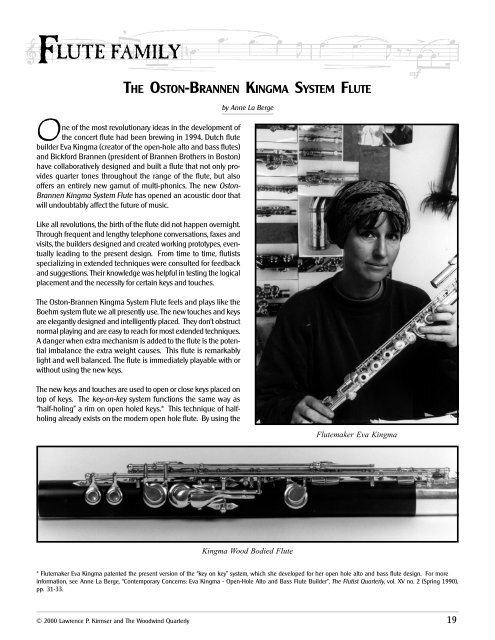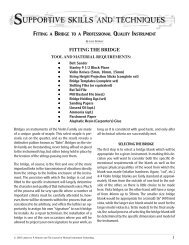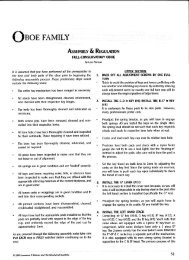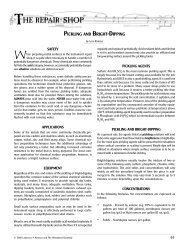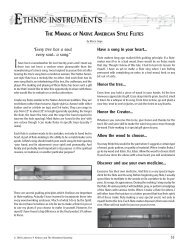The Kingma Flute - Music Trader Index Page
The Kingma Flute - Music Trader Index Page
The Kingma Flute - Music Trader Index Page
You also want an ePaper? Increase the reach of your titles
YUMPU automatically turns print PDFs into web optimized ePapers that Google loves.
FLUTE FAMILY<br />
THE OSTON-BRANNEN KINGMA SYSTEM FLUTE<br />
One of the most revolutionary ideas in the development of<br />
the concert flute had been brewing in 1994. Dutch flute<br />
builder Eva <strong>Kingma</strong> (creator of the open-hole alto and bass flutes)<br />
and Bickford Brannen (president of Brannen Brothers in Boston)<br />
have collaboratively designed and built a flute that not only provides<br />
quarter tones throughout the range of the flute, but also<br />
offers an entirely new gamut of multi-phonics. <strong>The</strong> new Oston-<br />
Brannen <strong>Kingma</strong> System <strong>Flute</strong> has opened an acoustic door that<br />
will undoubtably affect the future of music.<br />
Like all revolutions, the birth of the flute did not happen overnight.<br />
Through frequent and lengthy telephone conversations, faxes and<br />
visits, the builders designed and created working prototypes, eventually<br />
leading to the present design. From time to time, flutists<br />
specializing in extended techniques were consulted for feedback<br />
and suggestions. <strong>The</strong>ir knowledge was helpful in testing the logical<br />
placement and the necessity for certain keys and touches.<br />
<strong>The</strong> Oston-Brannen <strong>Kingma</strong> System <strong>Flute</strong> feels and plays like the<br />
Boehm system flute we all presently use. <strong>The</strong> new touches and keys<br />
are elegantly designed and intelligently placed. <strong>The</strong>y don’t obstruct<br />
normal playing and are easy to reach for most extended techniques.<br />
A danger when extra mechanism is added to the flute is the potential<br />
imbalance the extra weight causes. This flute is remarkably<br />
light and well balanced. <strong>The</strong> flute is immediately playable with or<br />
without using the new keys.<br />
<strong>The</strong> new keys and touches are used to open or close keys placed on<br />
top of keys. <strong>The</strong> key-on-key system functions the same way as<br />
“half-holing” a rim on open holed keys.* This technique of halfholing<br />
already exists on the modern open hole flute. By using the<br />
by Anne La Berge<br />
<strong>Flute</strong>maker Eva <strong>Kingma</strong><br />
<strong>Kingma</strong> Wood Bodied <strong>Flute</strong><br />
* <strong>Flute</strong>maker Eva <strong>Kingma</strong> patented the present version of the “key on key” system, which she developed for her open hole alto and bass flute design. For more<br />
information, see Anne La Berge, “Contemporary Concerns: Eva <strong>Kingma</strong> - Open-Hole Alto and Bass <strong>Flute</strong> Builder”, <strong>The</strong> Flutist Quarterly, vol. XV no. 2 (Spring 1990),<br />
pp. 31-33.<br />
© 2000 Lawrence P. Kirmser and <strong>The</strong> Woodwind Quarterly 19
<strong>The</strong> Oston-Brannen <strong>Kingma</strong> System <strong>Flute</strong><br />
key-on-key system, performers can now half-hole keys which normally<br />
their fingers can’t reach. In other words, it is possible to<br />
depress the rim of six more keys than was previously the case. By<br />
using the new touches and keys (on keys), it is possible to play six<br />
new quarter tones and many new multi-phonics. Until now, the<br />
standard open hole flute could play the quarter tones D # high, E<br />
high, F high, G # high, A high, C # high (with the C # trill key). <strong>The</strong> rest<br />
(D high, F # high, G high, B b high, B high, C high) all required<br />
venting and cross-fingering. <strong>The</strong> cross-fingerings previously needed<br />
to produce a quarter tone are acoustically complex and have a<br />
variety of interesting but unstable colors. For example, the fingering<br />
used to produce the quarter tone between F # and G on the<br />
Boehm system flute in the first octave involves elaborate venting<br />
and cross-fingering (see Example 1).<br />
Example 1. Fingering for F # high on the Boehm System flute.<br />
It is impossible to depress the rim of the F # hole to play a more<br />
simple quarter tone because we don’t have enough fingers. An<br />
example of a simple quarter tone is the one between F and F # . This<br />
is produced by depressing the rim of the F key.<br />
On the Oston-Brannen <strong>Kingma</strong> System <strong>Flute</strong>, the F # key can be<br />
half-holed by depressing a touch which closes only the rim and<br />
leaves a small (key-on-key) key open. This quarter tone is acoustically<br />
similar to the normal tones of the flute, and much easier to<br />
finger than the old cross-fingering.<br />
Example 2. Fingering for F high on the Boehm System flute.<br />
<strong>The</strong>refore the Oston-Brannen <strong>Kingma</strong> System <strong>Flute</strong> offers us not<br />
only the acoustic variety of the old micro-tuning on the Boehm<br />
open hole flute (Example 1) but it gives us a new set of reliable and<br />
well-tuned quarter tones. By using the new options for half-holing,<br />
the potentials for fingering combinations extends the list of available<br />
multi-phonics too. <strong>The</strong> normal fingerings for the entire range<br />
of the flute have not changed.<br />
<strong>Flute</strong> Family<br />
Now that we have this instrument, what music shall we play on it?<br />
I spoke with a few flutists who have played this flute. Some of them<br />
are already performing on it, and each has exciting plans for future<br />
projects. Some will first play older pieces involving extended techniques,<br />
some have begun commissioning composers, some will<br />
improvise, and some are writing their own music. <strong>The</strong> general<br />
consensus was that there is a new world of sounds to discover on<br />
this instrument. Because every musician’s talents and tastes are<br />
different, the musical and pedagogical directions we take are guaranteed<br />
to be rich and full of surprises. Harrie Starreveld, professor<br />
of flute at the Sweelinck Conservatory in Amsterdam, will tackle the<br />
chamber music of Brian Ferneyhough and premiere a work by<br />
American composer Morris Weddington. Both of these composers<br />
write music which is complex and virtuosic, requiring long hours of<br />
dedicated practice. <strong>The</strong>ir music utilizes a full assortment of quarter<br />
tones, microtones and multiphonics. Starreveld plans to work out<br />
the possibilities of the instrument, to provide composers with information,<br />
and to “let the flute guide the future of its music.”<br />
Flutist/composer Jos Zwaanenburg is a member of the faculty of<br />
the Amsterdam School of the Arts and the Brighton University in<br />
England. Like most musicians specializing in new music, commissioning<br />
composers and seeking out new sonic and aesthetic possibilities<br />
is a lifestyle for him. Zwaanenburg’s reaction to the new<br />
flute is that it is ”….beautiful. Eva and Bickford have found terrific<br />
solutions to problems I have faced in my experiences and experiments<br />
on the alto and bass flutes.”<br />
Kate Lukas, professor of flute at Indiana University, performed<br />
Fukushima’s Mei for solo flute on the third prototype of the Oston-<br />
Brannen <strong>Kingma</strong> System <strong>Flute</strong> at the Kansas City Convention in<br />
August 1994. She had two days to practice on the flute before her<br />
performance. Her reaction at that time was that the flute was “made<br />
for pieces like this.” Subtle pitch and color inflections were easier to<br />
execute, and she felt that she could do more with the piece than<br />
she could on her own flute. <strong>The</strong> instrument handled like a conventional<br />
flute, and invited experimentation without requiring special<br />
skills in extended techniques. Her image of what the flute could do<br />
was expanded each time she ventured to try yet another new key or<br />
fingering.<br />
John Fonville, professor of flute at the University of California San<br />
Diego, and a pioneer in microtonal compositions and explorations<br />
on the conventional flute, wants to begin by cataloging the finger-<br />
Example 3. Fingering for F # high on the Oston-Brannen<br />
<strong>Kingma</strong> System flute.<br />
14k Gold/Silver Brannen-Cooper <strong>Kingma</strong> System <strong>Flute</strong><br />
20 © 2000 Lawrence P. Kirmser and <strong>The</strong> Woodwind Quarterly
<strong>Flute</strong> Family<br />
ing possibilities and their probable sonic results on the Oston-<br />
Brannen <strong>Kingma</strong> System <strong>Flute</strong>. He is inviting composers to write<br />
pieces for it. In his own compositions, he particularly wants to bring<br />
out the acoustic and musical strengths of the instrument. In addition,<br />
Fonville is developing exercises to build strength and speed at<br />
getting around microtonally on all the open hole and quarter tone<br />
flutes that he uses.<br />
This author’s first project is to intimately understand how the Oston-<br />
Brannen <strong>Kingma</strong> System <strong>Flute</strong> handles in many musical situations.<br />
My practice time is dedicated to exercises for the development of<br />
fluency, flexibility and an intuitive response to the flute. In my work,<br />
improvisation and composition come as a response to intuitive reactions.<br />
I am developing chamber music repertoire which uses the<br />
basic quarter tones and the new multiphonic families by commissioning<br />
composers and writing myself, and have written a piece for<br />
flute quintet which will be premiered at the NFA convention in<br />
Orlando, Florida.<br />
As I watch the development of the flute, I always marvel at the<br />
solutions flute makers and players find for design and music. Here<br />
again, it is a privilege to witness and take part in a truly remarkable<br />
stage of the flute’s evolution.<br />
Flutist/composer Anne La Berge grew up in Stillwater, Minnesota<br />
and is now based in Amsterdam, <strong>The</strong> Netherlands. Her education<br />
includes a Bachelor of <strong>Music</strong> degree from the University of New<br />
Mexico where she studied with Frank Bowen, a Master of <strong>Music</strong><br />
degree from the University of Illinois where she was a teaching<br />
assistant to Alexander Murray, and two years of theoretical research<br />
studies at the University of California San Diego. She was awarded<br />
the performance prize from the 1990 Darmstadt Ferenkursen für<br />
Neue Musik, and was a guest performer/teacher in the first European<br />
<strong>Flute</strong> Festival in 1993. La Berge has been on the faculty of<br />
the Amsterdam School for the Arts since 1989. Her works are published<br />
by Frog Peak <strong>Music</strong>, who have also released a CD of her<br />
works for flute called “Blow”.<br />
<strong>The</strong> Oston-Brannen <strong>Kingma</strong> System <strong>Flute</strong><br />
Addendum:<br />
Eva <strong>Kingma</strong>, Brannen Brothers and F & B Associates (makers of the<br />
Oston-Brannen flute) are pleased to announce the upcoming availability<br />
of a totally new concert flute designed to meet the increasing<br />
needs of flutists.<br />
This flute, the result of extensive collaboration between Eva <strong>Kingma</strong><br />
and Bickford Brannen, is the first C concert flute to offer a full<br />
quarter tone scale, as well as complete multiphonic venting, for the<br />
modern flute repertoire. Next to that, it gives the flutist increased<br />
possibilities to make corrections in intonation and tone colour.<br />
<strong>The</strong> Brannen/<strong>Kingma</strong> System flute is, in all respects, a Boehm system<br />
flute. All of the normal touch pieces and fingerings are where<br />
you would expect them to be. When playing this flute for the first<br />
time, it feels similar to the usual C flute. <strong>The</strong> extended possibilities<br />
are to be discovered in the course of time - once you need them,<br />
they are there.<br />
Eva <strong>Kingma</strong> is world-renowned for her pioneering work in developing<br />
the open hole and quarter tone alto and bassflutes. Her ingenious,<br />
patented “key on key” system is the most practical means of<br />
making this type of instrument possible.<br />
<strong>The</strong> Brannen flute has been accepted by flutists worldwide for a<br />
long time, and provides an exceptional foundation for this exciting<br />
project. Utilizing the renowned Cooper scales and headjoint designs,<br />
as well as one of the most sophisticated mechanisms available,<br />
it is truly a state-of-the-art flute.<br />
All <strong>Kingma</strong> System flutes come with B foot joint and C # trill key as<br />
standard features. <strong>The</strong> C # trill is necessary both as a multiphonic<br />
vent and for the production of two of the quarter tones. In addition<br />
to the standard Boehm mechanism, there are six extra keys; these<br />
are used to produce the quarter tones and multiphonic vents which<br />
are “missing” on the normal French model (open hole) flute. <strong>The</strong><br />
<strong>Kingma</strong> System is available on Brannen-Cooper flutes and on Oston-<br />
Brannen flutes.<br />
14K Gold Brannen-Cooper <strong>Kingma</strong> System <strong>Flute</strong><br />
© 2000 Lawrence P. Kirmser and <strong>The</strong> Woodwind Quarterly 21
<strong>The</strong> Oston-Brannen <strong>Kingma</strong> System <strong>Flute</strong><br />
<strong>Flute</strong> Family<br />
For additional information concerning the Brannen-Cooper <strong>Kingma</strong> System flute, please contact:<br />
Brannen Brothers<br />
58 Dragon Court - Woburn, MA 01801 - USA<br />
Tel: 617-935-9522 Fax: 617-937-3058<br />
For additional information concerning the Oston-Brannen <strong>Kingma</strong> System flute, please contact:<br />
Eva <strong>Kingma</strong>, flutemaker<br />
Hoofdstraat 10 - 9444 PB Grolloo - <strong>The</strong> Netherlands<br />
Tel/Fax: +31-592-501659 email: kingma@usa.net<br />
or, for the USA and Canada,<br />
F & B Associates<br />
9116 Lynx Loop NE - Albuquerque, NM 87122 - USA<br />
22 © 2000 Lawrence P. Kirmser and <strong>The</strong> Woodwind Quarterly
<strong>Flute</strong> Family<br />
<strong>The</strong> Oston-Brannen <strong>Kingma</strong> System <strong>Flute</strong><br />
Fingerings courtesy of Anne La Berge<br />
© 2000 Lawrence P. Kirmser and <strong>The</strong> Woodwind Quarterly 23


